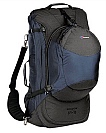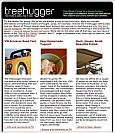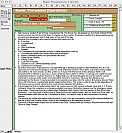Some examples of the different thinking employed by INOV8 (click images for larger view)
Watergate
is a patented (No. 630,019 - 5 March 1993) stormproof closure design for rain jackets. What sets it apart from
other closures is there are two zippers with an external zip flush to the outer fabric, providing a fast, yet positive
seal for wet weather apparel, especially compared to the snap fastener and velcro closures of the day. Although a
water resistant exterior zipper might be commonplace today, the Watergate design predates this by a decade.
The design has continued to be sold for over 15 years.
Shadow Travel Pack
The full 360 degree zip access of the Berghaus Shadow Travel Pack allows the user to enter the pack from
whenever they wish. This means they can find most of their possessions with little disturbance to other items.
To reduce sticky fingers have the same access, the cover flap was designed so it faced away from the opening
thus hiding the zipper pull tags from unwanted eyes.
Waterwall
was a new use for Gore-tex waterproof breathable fabric. The fabric had only seen limited use in the motorcycle
market. It was adapted to create a complete weather-tight seal, between a wearers mitts and jacket, by forming a
'S' passage that restricted any flow of water into the often poor seal that gloves make with jackets. (Also
developed for this glove program was a dual seam thumb for easier seam taping and a seamless thumb/palm
pattern that avoided the greatest point of wear and water ingress.)
AWA Newsletter
is an Portable Digital File (PDF) newsletter for the Australian Wetland Alliance. It is different from most because
articles are structured so they can be read across the page, without scrolling down. This is in direct contrast to
print media, where columns run down and require the reader to return to the top to continue reading. While fine
for print, with long columns this becomes exceedingly frustrating on computer screens. This design format
avoids that problem.
Treehugger Weekly Newletter
The ease of reading concept mentioned above was retained for the email based newsletter for
www.treehugger.com. But having a strong visual presence the Treehugger newsletter required images to be
included. So a three column format with a header photo was developed, so three articles could be read without
needing the reader to scroll
The Bower Computer Systems
were mostly all paper based. I designed a computerised system, for what is basically a retail operation for pre-
loved goods. The system now captures and manages Retail Sales, Laybys, Prop Hiring, Consignment, Contacts,
Banking, Workshop Repairs, Electrical Testing, Staff Purchases, Store Vouchers, Customer Referrals, Co-op
Membership, as well as Policy and Procedures for Operations and OH&S. All of which is coordinated through
searchable databases.
Travelwear
Long before the craze for big patch pockets and zip-off pants legs swept the world, I designed a line of travel
clothing to broke many traditions. The pants, for example, weighed less than half that of jeans, and packed to
about one fifth the size. They had no pockets on back, so the wearer stood less chance of being pickpocketed.
Security pockets were zippered and could be accessed while sitting on a bus or plane. They could be washed in
a hotel basin and drip dried overnight. I also selected a formaldehyde-free 'green cotton' and polyester blend.
Bicomponent Bodywear
is where the knit of next-to-skin fabric has a denser exterior to the interior. This creates a funnel effect so that
moisture, such as perspiration, is moved (via a capillary action) from the skin to the outside where it might
evaporate. Thus keeping the wearer dry and comfortable. I designed apparel with three versions of this fabric
construction, when such materials were only available from one supplier in the world, back in 1987. The
clothing was also styled so that it could be worn in its own right and not look like 'underwear'.
3D Pockets
were a feature of mountaineering shell garments designed for the Berghaus flagship Extrem range. Using
variation of pattern-making that creates articulated (pre-bent) knees in pants I was able develop a cargo pocket
that sat smooth on the exterior of the jacket. But when the pocket was loaded with items the pocket expanded
outwards, away from the wearer, to absorb the new contents. They went from flat to three dimensional merely by
adding contents.
Intercept
was a complete insulation package for outdoor wear. The insulation was a flexible, high performance wadding,
that we quilted to a featherweight version of the bicomponent knit noted above. Then sewn to a windproof
outer shell. The result being garments that were utterly dependable in cold, windy climes. Durable, warm, wind
and shower resistant, moisture wicking, soft, and compressible. The proverbial bee knees. (See a review of the
Aqtash, where I updated the concept years later)
Bleedless Printing
Although using post consumer recycled, or tree free paper, combined with vegetable based inks has always been
a goal with INOV8 print design projects, most have another another subtle but important difference. In print
production, when text or images go to the edge of paper this is known as a 'bleed'. INOV8 designs avoids the
bleed, because this requires the printer to trim the excess near the edge of the paper so the ink is flush. This
trimmed paper cannot be easily recycled because it must first be de-inked resulting in a polluting sludge.
Fleece Garments from Recycled PET Drink Bottles
As far as I can ascertain, I was the first designer outside of North America to place an order for the Dyersburg
E.C.O. fleece fabric, made from 89% recycled PET drink bottles. Also known as Wellman's EcoSpun fibre. I
would later, as a freelance agent, provide the Paddy Pallin group with 100% polyester Eco zippers (no metal
slider, no cotton tape, etc), from Salmi of Finland, so they could make, what I understand was, the first high
recycled content polyester (PET) apparel, that could be itself later be recycled. Because now all the components
were polyester.












